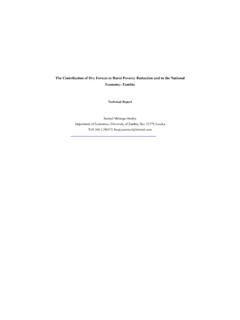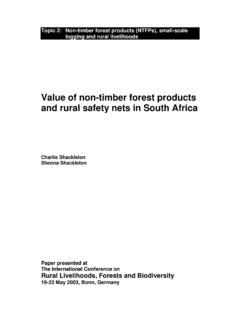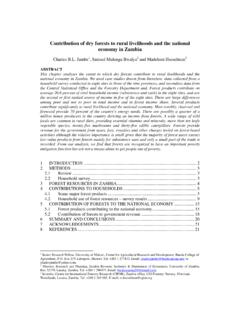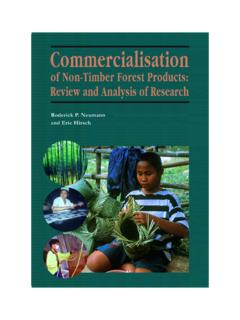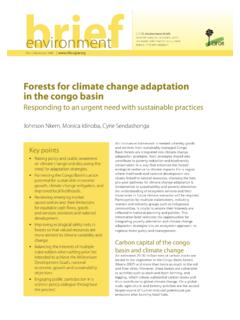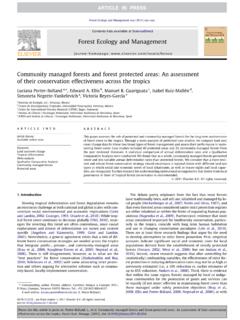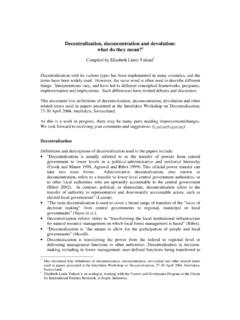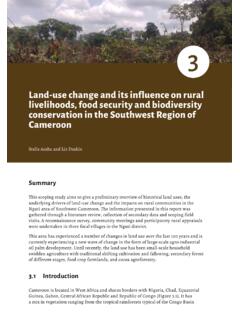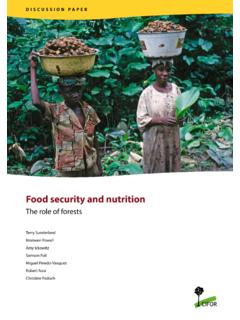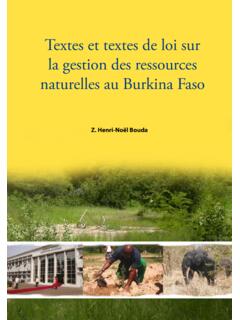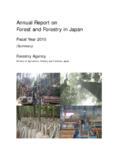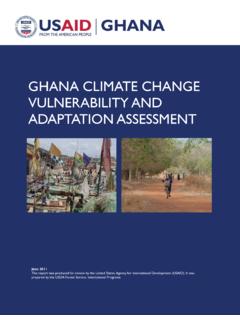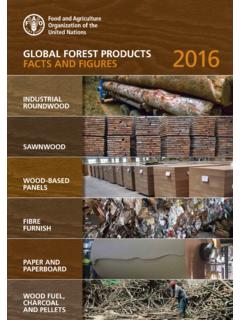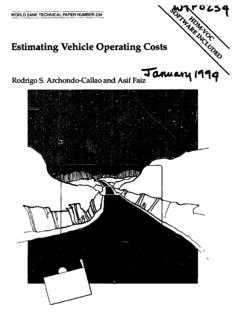Transcription of Dynamics of the charcoal and indigenous timber trade in …
1 OCCASIONAL PAPER. Dynamics of the charcoal and indigenous timber trade in Zambia A scoping study in Eastern, Northern and Northwestern provinces Davison J. Gumbo Kaala B. Moombe Mercy M. Kandulu Gillian Kabwe Marja Ojanen Elizabeth Ndhlovu Terry Sunderland OCCASIONAL PAPER 86. Dynamics of the charcoal and indigenous timber trade in Zambia A scoping study in Eastern, Northern and Northwestern provinces Davison J. Gumbo CIFOR, Zambia Kaala B. Moombe CIFOR, Zambia Mercy M. Kandulu Forest Department Lusaka Province, Zambia Gillian Kabwe Copperbelt University, Zambia Marja Ojanen Finnish Embassy, Zambia Elizabeth Ndhlovu Finnish Embassy, Zambia Terry C. H. Sunderland CIFOR, Indonesia Occasional Paper 86. 2013 Center for International Forestry Research All rights reserved ISBN 978-602-1504-02-4. Gumbo, D. J.
2 , Moombe, K. B., Kandulu, M. M., Kabwe, G., Ojanen, M., Ndhlovu, E. and Sunderland, 2013. Dynamics of the charcoal and indigenous timber trade in Zambia: A scoping study in Eastern, Northern and Northwestern provinces. Occasional Paper 86. CIFOR, Bogor, Indonesia. Cover photo by Terry Sunderland Photos by Davison Gumbo, except Figure 6 by Gillian Kabwe CIFOR. Jl. CIFOR, Situ Gede Bogor Barat 16115. Indonesia T +62 (251) 8622-622. F +62 (251) 8622-100. E Any views expressed in this publication are those of the authors. They do not necessarily represent the views of CIFOR, the authors' institutions or the financial sponsors of this publication. Table of contents Acknowledgements v Acronyms and abbreviations vi Preface vii Summary viii 1 Introduction 1. Objectives 2. Methods 3. Selection of study districts 5.
3 2 Literature review 11. charcoal production 11. charcoal trade 16. Regional forest management policy frameworks 18. Foreign direct investment and local land losses 19. The legal and forest policy framework in Zambia 20. 3 charcoal production and trade 23. The charcoal production cycle 24. Production areas 25. Species used in charcoal production 27. Production trends 27. Movement of charcoal to border towns and beyond 29. Routes and modes of transport 30. charcoal production control mechanisms 31. Trading regulations for charcoal 32. charcoal distribution and markets 32. Reasons for engaging in charcoal production 34. Markets for charcoal in border areas 34. Value addition along the trade chain 37. Cost structure of the charcoal value chain 38. 4 indigenous timber production and trade 42. Policy and institutional frameworks guiding timber production 42.
4 Actors in timber production and trade 44. timber production cycles and processes 44. timber production 46. Marketplaces and buyers of indigenous timber 49. 5 Conclusions and recommendations 52. Introduction 52. Findings 53. Methods and tools revisited 53. Revisiting specific objectives and outputs of the study 53. 6 References 62. Annexes 69. List of figures and tables Figures 1 Stages of the scoping study process 3. 2 Provinces in this study (outlined in blue) 5. 3 Northwestern province, showing study districts of Mwinilunga and Kasempa 6. 4 SADC transport development corridors 10. 5 A typical 50 kg bag of charcoal 24. 6 A 50 kg bag of charcoal with a 30 cm head 24. 7 A burning earth kiln in Nyimba district 24. 8 Kiln under construction on land cleared for cultivation in Nyimba district 25. 9 Site of a former kiln, showing limited tree regeneration 26.
5 10 kaLicensi Kalipo (licence is available) - talking to a charcoal producer-retailer on the Chipata-Lundazi road 30. 11 Female traders loading a 50 kg bag onto a Chipata-bound bus in Nyimba district 32. 12 Approximate consumption of charcoal by district 33. 13 Prices of charcoal in border towns 35. 14 Example of generic charcoal trade flows (Eastern province) 37. 15 Cost benefit ratio for charcoal trading 40. Tables 1 Attributes of provinces studied 6. 2 Volumes of commercial timber species by province 7. 3 Characteristics of the study provinces and districts 8. 4 Border towns included in scoping study 9. 5 Literature search on use of charcoal in the study area 12. 6 Trends in charcoal production and consumption 11. 7 Tree species used for charcoal production 14. 8 Informal charcoal and timber cross-border exports out of Tanzania 1995 1996 18.
6 9 Abbreviations for districts and border towns in the study area 23. 10 Sources of charcoal entering the study districts 26. 11 Trees used for charcoal production 28. 12 Do producers obtain permission to make charcoal ? 30. 13 Number of markets, quantities of bags and charcoal on the Luangwa-Chipata Road 31. 14 External markets linked to the study districts 33. 15 Reasons people engage in charcoal production in the various districts 34. 16 Destinations of charcoal produced in or ferried through border areas 35. 17 Peak months for charcoal prices in border towns 36. 18 Months when charcoal prices are lowest in border towns 36. 19 charcoal production costs in a calendar year within the study districts 39. 20 Prices for charcoal in districts 40. 21 Requirements for issuance of forest logging licences in Zambia 43.
7 22 Documents and costs associated with application for pit-sawing licence 45. 23 Tree species extracted for timber 46. 24 timber production months 47. 25 Local markets and routes for timber in border towns 47. 26 Seasonal timber inflows into border towns 48. 27 Sources of timber ferried through the districts 48. 28 Markets for indigenous timber 49. 29 Average prices of indigenous timber in districts 50. 30 Seasonal variation in timber prices 50. Acknowledgements We would like to record our gratitude to Vainess Our special thanks go to their Royal Highnesses Phiri, Daniel Banda, Joseph Sambondu, Kingsley or their representatives who attended the district Muyeba, Mupelesi Siame, Rex Mukunta, validation meetings. Sarah Lunda, Christine Zulu and Miriam Suntwe, all of whom provided invaluable We also thank the many charcoal and timber field support.
8 We would also like to thank the producers, traders, retailers and transporters District Commissioners for Chinsali, Nakonde, who provided invaluable information for this Mwinilunga, Kasempa, Nyimba and Katete, who study. Financial support for this study and the graced the various district validation meetings. district validation meetings was provided by the Finnish Embassy in Lusaka, which is gratefully We also note the contributions of the Provincial acknowledged. Extension Officers (Eastern, Northern and Northwestern), the Zambia Revenue Authority The authors also thank two anonymous reviewers and representatives of the Forest Department, and James Culverwell for his editorial skills in the Agriculture, Social Welfare and District Councils. final preparation of this report. Acronyms and abbreviations CBR Cost Benefit Ratio CHAPOSA charcoal Potential in Southern Africa CDM Clean Development Mechanism CO Carbon Monoxide CO2 Carbon Dioxide COMACO Community Markets for Conservation COMESA Common Market for Eastern and Southern Africa CSO Central Statistical Office DRC Democratic Republic of the Congo EIA Environmental Impact Assessment EPPCA Environmental Protection and Pollution Control Act FAO Food and Agriculture Organization of the United Nations FCPF Forest Carbon Partnership Facility (The World Bank).
9 FD Forest Department FDHQ Forest Department Headquarters FDI Foreign Direct Investment GMA Game Management Area GDP Gross Domestic Product GPS Global Positioning System GRZ Government of the Republic of Zambia ICBT Informal Cross-Border trade ICRAF World Agroforestry Centre JFM Joint Forest Management JICA Japan International Cooperation Agency MEWD Ministry of Energy and Water Development MWK Malawian Kwacha NGO Non-Governmental Organisations NJP National Joint Programme PFAP Provincial Forest Action Programme REDD Reducing Emissions from Deforestation and Forest Degradation RISDP Regional Indicative Strategic Development Plan SADC Southern African Development Community SEI Stockholm Environment Institute SFM Sustainable Forest Management SMFE Small- and Medium-Scale Forest Enterprises SSA Sub-Saharan Africa TZS Tanzanian Shilling UNEP United Nations Environment Programme UNEP-WCMC UNEP - World Conservation Monitoring Centre UNESCO United Nations Educational, Scientific and Cultural Organization ZAWA Zambia Wildlife Authority ZDA Zambia Development Agency ZRA Zambia Revenue Authority ZESCO Zambia Electricity Supply Corporation ZFAP Zambia Forest Action Programme ZIMOZA Zimbabwe, Mozambique and Zambia ZMM-GT Zambia Malawi Mozambique Growth Triangle Preface This report presents the results of a scoping The report calls for closer attention to local-level study in six districts in Eastern, Northern (now resource management systems based on traditional Muchinga) and Northwestern provinces of control mechanisms, formalised through by-laws at Zambia.
10 The study highlights the significant the district level. Such efforts should be supported contributions of both charcoal and timber to by multi-disciplinary research covering the the livelihoods of rural households. Contrary to biophysical and social aspects of the charcoal and a general understanding that charcoaling always timber industries. In the case of timber , this study leads to deforestation, this study discovered established the existence of an organised system that certain areas used for charcoal production of production and trade , but identified a need for for extended periods of time demonstrate the producers, especially pit sawyers, to be actively existence of sustainable, locally managed charcoal supported and the licensing process affecting production systems. them decentralised. Summary Objectives of the scoping study of recommendations were derived.
